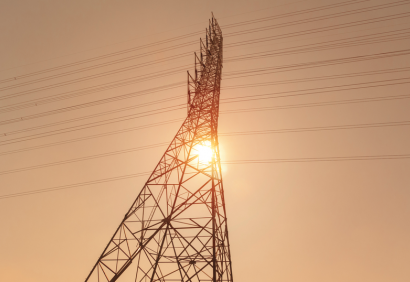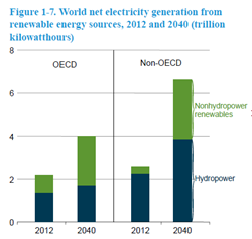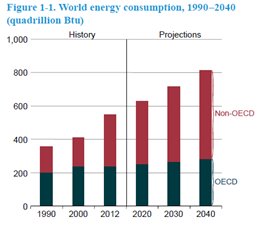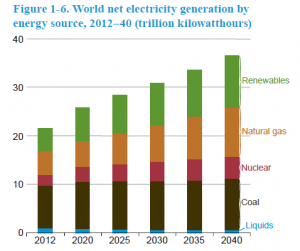
In talking about how to decarbonize the energy grid, we must get past the renewables vs. baseload debate. We need both, and fusion breakthroughs can help.
By: Derek A. Sutherland, CEO of CTFusion
There is an ever-increasing demand for consumable energy worldwide. The U.S. Energy Information Administration (EIA) in the 2016 International Energy Outlook (IEO) report projects worldwide energy demand increasing into the mid-21st century. Worldwide energy consumption was dominated by countries within the Organization for Economic Co-operation and Development (OECD), a group of mainly rich, developed nations, until the end of the 20th century. However, since roughly the beginning of the 21st century, energy consumption by Non-OECD countries overtook that of the OECD block, and should continue to increase into the 2040s. This increase in demand is to be expected as developing nations continue to industrialize, become wealthier, and have corresponding improvements in quality of life for billions of people. Total worldwide energy consumption is forecasted to increase from approximately 549 quadrillion British thermal units (BTUs) in 2012 to 815 quadrillion BTUs in 2040. I argue this increase in energy demand will need to be met with new, base-load energy sources in addition to renewables to avoid a future that continues to be dominated by greenhouse-gas producing fossil fuels.
With such strong growth forecasted in global energy demand, and with environmental concerns such as anthropogenic climate change and pollution ever present, it would be desirable for the corresponding increase in consumable energy production to come from non-polluting, greenhouse-gas emission free energy sources. Fortunately, the EIA forecasts strong growth of renewable energy sources for electricity generation at an average rate of 2.6% per year from 2012-2040. However, even though this growth rate is the largest out of all energy sources considered, due to their relatively small market share at present, renewables will likely maintain a minority market share relative to fossil fuels until at least 2040.
The bulk of worldwide electricity production (57%) is forecasted to come from fossil fuel energy sources in 2040 (i.e. natural gas and coal) even when assuming the average 2.6%/ per year increase in renewables, and an average growth rate of greenhouse-gas emission free nuclear power of 2.3% per year which is quite uncertain due to regulatory difficulties and low levels of public acceptance. Renewable energy sources are forecasted to have a 29% market share in 2040, which is a notable increase from its 22% share in 2012. However, it is important to note that most of renewable electricity production came from hydropower in 2012, and this trend is forecasted to continue through 2040 despite increasing use of wind, solar, and other transient renewable energy sources in both OECD and Non-OECD countries.

Worldwide net electricity generation (trillion kilowatt-hours) by renewable sources projected to 2040.
Assuming these projections come to pass (a big assumption given that EIA has been notably wrong about long term projections for years), energy markets will continue to be dominated by base-load energy sources (e.g. coal, nuclear power, hydropower, etc..), or in other words, energy sources that supply nearly constant amounts of power over time and are capable of being on-demand to varying extents. Variable energy sources, such as wind and solar power, must be coupled with large amounts of energy storage or backup, on-demand power plants to ensure power is always available when needed. Widespread, grid-scale energy storage facilities are not presently available; on-demand, backup power plants (e.g. natural gas) seem the more likely option to support a renewable-dominated electric grid. In short, these projections indicate a baseload-dominated grid into mid-21st century, and in the case of even stronger transient renewable growth than forecasted, the transition to a transient renewable-dominated energy grid would likely be enabled through the support of on-demand, base-load power plants.
Thus, there is and will likely continue to be a need for alternative, base-load energy sources that will enable the more rapid decarbonizing of electrical grids than these projections forecast. One such opportunity is that of fusion energy, which I wrote about at length in my January 27th article The Prospect of Fusion Energy. In short, fusion enjoys the strengths of fission energy while avoiding the weaknesses. Fusion power produces no greenhouse-gas emissions, has high power density, and corresponding small physical footprint. A fusion power plant cannot have a meltdown, has no long-lived radioactive waste, and uses readily accessible fuel from water that cannot be proliferated and used for nefarious purposes. Fusion is a breakthrough green energy source that could have a dramatic effect on the make-up of the base-load electric grid by directly competing with, and ultimately replacing coal and natural gas power plants. Instead of a projected 57% market share of these two energy sources in 2040, fusion could encompass a large fraction of the market if expedited research and development programs are undertaken that are geared to developing economical fusion energy.
And therein lies the key for such a future to come to pass. A notable challenge for fusion energy that will need to be overcome is producing electricity for a price that is as expensive, or ideally cheaper, than fossil fuel energy sources. Provided with economic competitiveness and the ability to take the place of fossil fuel power plants with minimal grid modifications, an aggressive growth rate in the use of fusion energy is possible. So long as innovative, timeline shortening, cost-cutting ideas continue to be researched and developed in the fusion sector, and there is sustained demand for base-load energy sources, fusion power will find a welcoming electricity market once ready for deployment.




Write a comment: